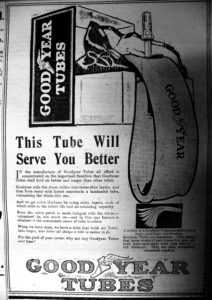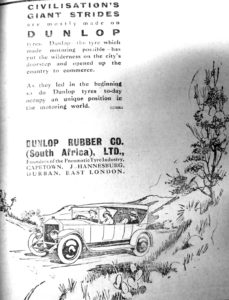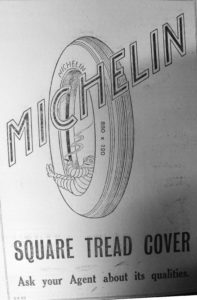97 YEARS AGO IN GROCOTT’S MAIL:
Dunlop and Goodyear and Michelin, Oh My
On 22 September 1920, Grocott’s printed not one, not two, but three advertisements for rubber tyres – one for Dunlop, one for Michelin, one for Goodyear. In those days, most of the rubber used for tyres was natural. Rubber trees were native to South America, and the continent supplied most of the world’s rubber until the late 1890s. Brazil was so jealous of their monopoly on rubber that it was a capital offence to export seeds, but Henry Wickham didn’t care: in 1876, he smuggled 70 000 seeds out of Brazil to Kew Gardens in England. Only a few thousand of them germinated, but this was enough: seedlings sent to India, Sri Lanka, Indonesia and Malaysia founded vast plantations in British and Dutch colonial territories there, as well as in the Congo Basin, and in what is now Vietnam.

The demand for rubber to make inner tubes and outer casings for car tyres exploded in the early 1900s. Dunlop, founded by John Boyd Dunlop and Harvey du Cros in Ireland, made its first car tyre in 1900, and added aeroplane tyres and golf balls in 1910. Edouard and Andre Michelin of France patented a removable pneumatic tyre in 1889, and the American Goodyear company started making car tyres in 1899. World War One increased demand for rubber steeply.
By 1917, Dunlop owned 60 000 acres of rubber plantations, making it the UK’s 14th largest manufacturer. By 1922, Britain controlled 75% of the world’s rubber plantations, and its vast colonial holdings provided a big market for tyres and other rubber products. But trouble was coming: there were now too many rubber trees, planted to supply World War One’s demand, and after 1918, they weren’t needed. The rubber price yo-yo’d in the 1920s. In 1930, labour conditions on Michelin’s Asian plantations were so bad that Communist Party supporters there organised the Phu Rieng Do Strike, bringing the French rubber trade to a standstill. This strike foreshadowed many other Communist-led strikes in the Rubber Belt, and fuelled anti-colonialist struggles.

Today, Dunlop, Goodyear and Michelin are still around – and their logos look pretty much the same, except that the Michelin Man has put on some weight, quit smoking, and lost his glasses …

Queries, suggestions, tips and corrections to nervousflamingo@gmail.com.



